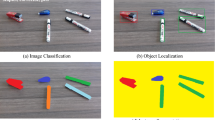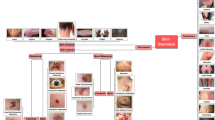Abstract
It is realized that fixed thresholds mostly fail in two circumstances as they only search for a certain range of skin color: (i) any skin-like object may be classified as skin if skin-like colors belong to fixed threshold range; (ii) any true skin for different races may be mistakenly classified as non-skin if that skin colors do not belong to fixed threshold range. In this paper, graph cuts (GC) is first extended to skin color segmentation. Although its result is acceptable, a complex environment with skin-like objects or different skin colors or different lighting conditions often results in a partial success. It is also known that probability neural network (PNN) has the advantage of recognizing different skin colors in cluttered environments. Therefore, many images with skin-like objects or different skin colors or different lighting conditions are segmented by the proposed algorithm (i.e., the combination of GC algorithm and PNN classification with other functions, e.g., morphology filtering, labeling, area constraint). The compared results among GC algorithm, PNN classification, and the proposed algorithm are presented not only to verify the accurate segmentation of these images but also to reduce the computation time. Finally, the application to the classification of hand gestures in complex environment with different lighting conditions further confirms the effectiveness and efficiency of our method.
















Similar content being viewed by others
References
Hwang CL, Lu KD (2011) The segmentation of different skin colors using the combination of graph cuts and probability neural network. IWANN’11, Malaga, pp 25–33, 8–10 June 2011
Zhang MJ, Gao W (2005) An adaptive skin color detection algorithm with confusing backgrounds elimination. IEEE ICIP2005, p 2, 11–14 Sept 2005
Yogarajah P, Condell J, Curran K, Cheddad A, McKevitt P (2010) A dynamic threshold approach for skin segmentation in color images. IEEE international conference on image processing, Hong Kong, pp 2225–2228, 26–29 Sept 2010
Kakumanu P, Makrogiannis S, Bourbakis N (2007) A survey of skin-color modeling and detection methods. Pattern Recognit 40:1106–1122
Liensberger C, Stöttinger J, Kampel M (2009) Color- based and context-aware skin detection for online video annotation. IEEE international workshop on multimedia signal processing, MMSP ’09, Rio De Janeiro, pp 1–6, 5–7 Oct 2009
Cao XY, Liu HF, Zou YY (2011) Gesture segmentation based on monocular vision using skin color and motion cues. In: IEEE international conference on image analysis and signal processing, Zhejiang, pp 358–362, 9–11 April 2011
Han J, Awad G, Sutherland A (2009) Automatic skin segmentation and tracking in sign language recognition. IET Comput Vis 3(1):24–35
Wang ZG, Liu CL (2009) A method of dynamic skin color correction applied to display devices. IEEE Trans Consum Electron 55(3):967–972
Sun M, Liu Z, Qiu J, Zhang Z, Sinclair M (2009) Active lighting for video conferencing. IEEE Trans Circuit Syst Video Technol 19(12):1819–1823
Veredas F, Mesa H, Morente L (2010) Binary tissue classification on wound images neural networks and Bayesian classifiers. IEEE Trans Med Imaging 29(2):410–427
Tsai CM, Yeh ZM (2010) Contrast compensation by fuzzy classification and image illumination analysis for back-lit and front-lit color face images. IEEE Trans Consum Electron 56(3):1570–1578
Deng Y, Yang Q, Lin X, Tang X (2007) Stereo correspondence with occlusion handling in a symmetric patch-based graph-cuts model. IEEE Trans Pattern Anal Mach Intell 29(6):1068–1079
Tao W, Jin H, Zhang Y, Liu L, Wang D (2008) Image threshold using graph cuts. IEEE Trans Syst Man Cybern Part C 38(5):1181–1195
Raj A, Wiggins CH (2010) An information-theoretic derivation of min-cut-based clustering. IEEE Trans Pattern Anal Mach Intell 32(6):988–995
Papadakis N, Bugeau A (2011) Tracking with occlusions via graph cuts. IEEE Trans Pattern Anal Mach Intell 33(1):144–157
Cho SY (2008) Probabilistic based recursive model for adaptive processing of data structures. Expert Syst Appl 34:1403–1422
Zhoua F, Liua J, Yua Y, Tiana X, Liub H, Haoa Y, Zhanga S, Chena W, Dai J, Zheng X (2010) Field- programmable gate array implementation of a probabilistic neural network for motor cortical decoding in rats. J Neurosci Methods 185:299–306
Perera N, Rajapakse AD (2011) Recognition of fault transients using a probabilistic neural-network classifier. IEEE Trans Power Deliv 26(1):410–419
Psyllos A, Anagnostopoulos CN, Kayafas E (2011) Vehicle model recognition from frontal view image measurements. Comput Stand Interfaces 33:142–151
Haykin S (1999) Neural networks: a comprehensive foundation. Prentice Hall International Inc., Englewood
Phung SL, Bouzerdoum A, Chai D (2005) Skin segmentation using color pixel classification: analysis and comparison. IEEE Trans Pattern Anal Mach Intell 27(1):148–154
Juang CF, Chiu SH, Shiu SJ (2007) Fuzzy system learned through fuzzy clustering and support vector machine for human skin color segmentation. IEEE Trans Syst Man Cybern Part A 37(6):107–116
Temurtas F (2009) A comparative study on thyroid disease diagnosis using neural networks. Expert Syst Appl 36:944–949
Sonka M, Hiavac V, Boyle R (2008) Image processing, analysis, and machine vision, 3rd edn. Cengage Learning, Florence
Hwang CL, Yang CH (2011) Command control of a two-degree-of-freedom platform by hand gesture moment invariants. IWANN’11, Malaga, pp 223–231, 8–10 June 2011
Acknowledgments
The authors want to thank the financial support from the project of NSC-99-2221- E-011-16 -MY3 of Taiwan, ROC.
Author information
Authors and Affiliations
Corresponding author
Rights and permissions
About this article
Cite this article
Hwang, CL., Lu, KD. & Pan, YT. Segmentation of Different Skin Colors with Different Lighting Conditions by Combining Graph Cuts Algorithm with Probability Neural Network Classification, and its Application. Neural Process Lett 37, 89–109 (2013). https://doi.org/10.1007/s11063-012-9275-4
Published:
Issue Date:
DOI: https://doi.org/10.1007/s11063-012-9275-4




